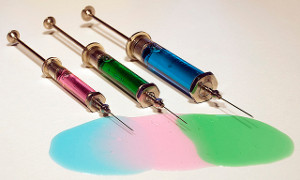 Could handling e-liquid really be as safe as doing the dishes?
Could handling e-liquid really be as safe as doing the dishes?
European regulations on classification, labelling and packaging (CLP) have been wrongly categorising nicotine as extremely toxic when it should be considered the equivalent of washing-up liquid, a new report claims.
The Electronic Cigarette Industry Trade Association (ECITA) commissioned specialist toxicological consultancy Bibra to determine the acute oral and dermal toxicity of nicotine solutions – toxicity when nicotine is ingested or absorbed through exposed skin.
ECITA then took this information and determined exactly where it believed nicotine solutions of less than 2.5% and 2.5-5% should fall under the EU’s CLP regulations (regulation 1272/2008).
It found that solutions of less than 2.5% should not be classified at all, while those in the 2.5-5% range should be given the lowest (category 4) classification, putting them on an equivalent level to household products such as washing-up liquid.
This differs from the current CLP classifications of nicotine, where a 2.5% solution is considered a category 3 product (making it the equivalent of formaldehyde for packaging and labelling purposes) and 2.5-5% solutions are category 2 – the equivalent of strychnine.
The reasoning for the harsher stance from regulators is unclear but likely linked to differences in advisory comment from sources in each member state.
“While [ECITA] have long been aware that most of the media and regulatory attention surrounding the risks of nicotine solutions were hyperbole, and exaggerated the risks, we did not anticipate quite this scale of exaggeration,” the organisation said.
ECITA said it peer-reviewed the findings with three independent experts on nicotine, and that all agreed with Bibra’s research methodology and findings.
This included: “Professor Bernd Mayer, professor and chairman of the Department of pharmacology and toxicology at Karl-Franzens-University, Graz; Professor Riccardo Polosa, full professor of internal medicine at the University of Catania; and Dr Jacques Le Houezec, an independent consultant in public health and tobacco dependence, and honorary lecturer at the UK Centre for Tobacco Control Studies, University of Nottingham.
All of whom agreed with Bibra’s research methodology and findings. “It seems fairly conclusive, therefore, that the generally assumed CLP (or CPL, for most non-English-speaking countries) classification of nicotine is in fact, incorrect,” ECITA argued.
Professor Robert West at University College London’s Department of Epidemiology and Public Health told ECigintelligence: “The proposed classification is much more in line with the evidence on e-liquid toxicity than the current EU classification and I would imagine that EU officials would want to take this proposal very seriously.”
Watch out, all the same
However, although ECITA would like to see nicotine CLP classifications dropped to the applicable lower categories, it acknowledged that nicotine e-liquids still present a danger – particularly for children, to whom ingestion can be fatal, and for pets such as cats that cannot metabolise the propylene glycol contained in the liquid.
The organisation would like to see a minimum level of consumer protection including:
• Child-resistant closures used on all e-liquid bottles.
• E-liquid labelling including, as a minimum, the heading “CAUTION:” and the text “Store locked up and out of the reach of children and pets”.
• Nicotine concentration in weight per volume (w/v) percentage and/or milligrams per millilitre (mg/ml) marked on the label.
• The text “Only for use in electronic cigarettes” and “Seek medical advice if you feel unwell”.
• Contact details for suppliers.
• Visible, legible and indelible printing for all label elements
What This Means: It undermines a major public safety criticism of e-cigarettes if nicotine is indeed significantly less toxic than generally assumed – especially considering the increasing number of media stories about poisoning, and mooted e-liquid bans on safety grounds.
However, regulations will not change based on a single study, especially one coming from the industry. And even if further analysis were to confirm ECITA’s findings, it seems unlikely politicians or regulators would listen very hard on what is otherwise a “protect-the-children, win-the-votes” issue that does not require a nuanced approach.
Protecting consumers from nicotine poisoning is an easy platform to stand on and there is little political capital in doing otherwise.
– Freddie Dawson ECigIntelligence staff
Photo: Darren Tunnicliff






